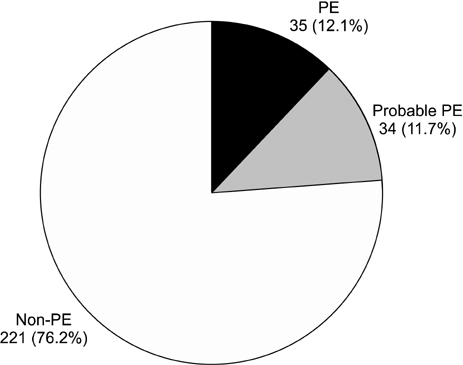World J Mens Health.
2013 Apr;31(1):70-75.
Self-Reported Prevalence of and Attitudes toward Premature Ejaculation in a Community-Based Study of Married Couples
- Affiliations
-
- 1Department of Urology, Chonnam National University Medical School, Gwangju, Korea. uropark@gmail.com
- 2Sexual Medicine Research Center, Chonnam National University, Gwangju, Korea.
- 3Department of Psychology, Chonnam National University, Gwangju, Korea.
Abstract
- PURPOSE
We evaluated the self-reported prevalence of and attitudes toward premature ejaculation (PE) in a community-based study of married couples.
MATERIALS AND METHODS
A community-based cross-sectional study of PE was conducted among married couples in Gwangju, Korea. Self-reported data were collected through the use of questionnaires, which included demographic questions, the Premature Ejaculation Diagnostic Tool (PEDT), the intravaginal ejaculation latency time (IELT), patient-reported outcome (PRO), and the Female Sexual Function Index (FSFI).
RESULTS
Of the 290 couples who completed the survey, the prevalence of PEDT-diagnosed PE including probable PE was 23.7% of men. By IELT measure, the prevalence of PE was 21.7% as reported by the men and 23.9% as reported by their partners, respectively. PRO responses indicated that control over ejaculation and severity of PE were not reported significantly differently by the men and their partners. Satisfaction with sexual intercourse was poorer for the men's partners than for the men. Personal distress and interpersonal difficulty were higher for the men than for their partners. The partners of men in the PE group had significantly lower FSFI scores than did the partners of men in the non-PE group.
CONCLUSIONS
The reporting of the prevalence of PE did not differ significantly between the men in this study and their partners. However, PE in men tended to impact their partners' sexual function.
Keyword
MeSH Terms
Figure
Reference
-
1. Patrick DL, Althof SE, Pryor JL, Rosen R, Rowland DL, Ho KF, et al. Premature ejaculation: an observational study of men and their partners. J Sex Med. 2005. 2:358–367.2. Park HJ, Park JK, Park K, Lee SW, Kim SW, Yang DY, et al. Prevalence of premature ejaculation in young and middle-aged men in Korea: a multicenter internet-based survey from the Korean Andrological Society. Asian J Androl. 2010. 12:880–889.
Article3. Dunn KM, Croft PR, Hackett GI. Sexual problems: a study of the prevalence and need for health care in the general population. Fam Pract. 1998. 15:519–524.
Article4. Nathan SG. The epidemiology of the DSM-III psychosexual dysfunctions. J Sex Marital Ther. 1986. 12:267–281.
Article5. Laumann EO, Paik A, Rosen RC. Sexual dysfunction in the United States: prevalence and predictors. JAMA. 1999. 281:537–544.6. Laumann EO, Nicolosi A, Glasser DB, Paik A, Gingell C, Moreira E, et al. GSSAB Investigators' Group. Sexual problems among women and men aged 40-80 y: prevalence and correlates identified in the Global Study of Sexual Attitudes and Behaviors. Int J Impot Res. 2005. 17:39–57.
Article7. Rosen RC, Althof S. Impact of premature ejaculation: the psychological, quality of life, and sexual relationship consequences. J Sex Med. 2008. 5:1296–1307.
Article8. McMahon CG, Lee G, Park JK, Adaikan PG. Premature ejaculation and erectile dysfunction prevalence and attitudes in the Asia-Pacific region. J Sex Med. 2012. 9:454–465.
Article9. Miner M, Hellstrom WJ. Distinguishing premature ejaculation from other sexual function disorders. Postgrad Med. 2008. 120:54–63.
Article10. Papaharitou S, Athanasiadis L, Nakopoulou E, Kirana P, Portseli A, Iraklidou M, et al. Erectile dysfunction and premature ejaculation are the most frequently self-reported sexual concerns: profiles of 9,536 men calling a helpline. Eur Urol. 2006. 49:557–563.
Article11. Rowland DL, Patrick DL, Rothman M, Gagnon DD. The psychological burden of premature ejaculation. J Urol. 2007. 177:1065–1070.
Article12. Ahn TY, Park JK, Lee SW, Hong JH, Park NC, Kim JJ, et al. Prevalence and risk factors for erectile dysfunction in Korean men: results of an epidemiological study. J Sex Med. 2007. 4:1269–1276.
Article13. Waldinger MD. Premature ejaculation: state of the art. Urol Clin North Am. 2007. 34:591–599.
Article14. Symonds T, Perelman MA, Althof S, Giuliano F, Martin M, May K, et al. Development and validation of a premature ejaculation diagnostic tool. Eur Urol. 2007. 52:565–573.
Article15. Rosen R, Brown C, Heiman J, Leiblum S, Meston C, Shabsigh R, et al. The Female Sexual Function Index (FSFI): a multidimensional self-report instrument for the assessment of female sexual function. J Sex Marital Ther. 2000. 26:191–208.16. Serefoglu EC, Saitz TR. New insights on premature ejaculation: a review of definition, classification, prevalence and treatment. Asian J Androl. 2012. 14:822–829.
Article17. Serefoglu EC, Cimen HI, Ozdemir AT, Symonds T, Berktas M, Balbay MD. Turkish validation of the premature ejaculation diagnostic tool and its association with intravaginal ejaculatory latency time. Int J Impot Res. 2009. 21:139–144.
Article18. Lee SW, Lee JH, Sung HH, Park HJ, Park JK, Choi SK, et al. The prevalence of premature ejaculation and its clinical characteristics in Korean men according to different definitions. Int J Impot Res. 2013. 25:12–17.
Article19. Hobbs K, Symonds T, Abraham L, May K, Morris MF. Sexual dysfunction in partners of men with premature ejaculation. Int J Impot Res. 2008. 20:512–517.
Article20. Symonds T, Roblin D, Hart K, Althof S. How does premature ejaculation impact a man s life? J Sex Marital Ther. 2003. 29:361–370.21. Byers ES, Grenier G. Premature or rapid ejaculation: heterosexual couples' perceptions of men's ejaculatory behavior. Arch Sex Behav. 2003. 32:261–270.22. Metz ME, Pryor JL. Premature ejaculation: a psychophysiological approach for assessment and management. J Sex Marital Ther. 2000. 26:293–320.
- Full Text Links
- Actions
-
Cited
- CITED
-
- Close
- Share
- Similar articles
-
- Clomipramine in the Treatment of Premature Ejaculation
- Prevalence and Knowledge of Premature Ejaculation in the Area of Busan
- Clinical Spectrum of Premature Ejaculation
- Sertraline Treatment in Premature Ejaculation: A Double Blind, Randomized, Placebo-Controlled Study
- Toward Evidence-Based Genetic Research on Lifelong Premature Ejaculation: A Critical Evaluation of Methodology


